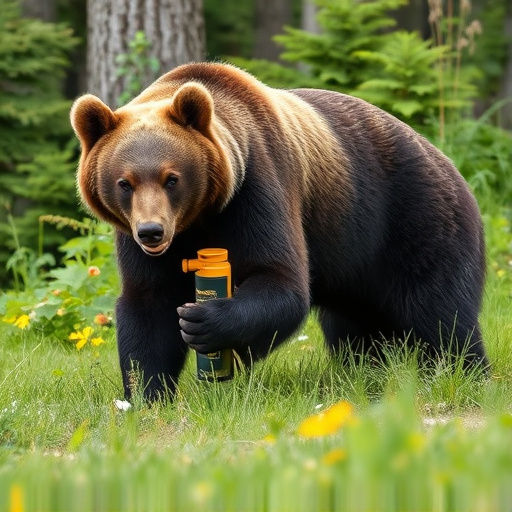Bear spray, a critical tool for wilderness adventurers facing aggressive bears, relies on capsaicin (from chili peppers) as its active ingredient, with percentages ranging from 10% to 34%. Choosing the right bear spray involves understanding capsaicin concentration, which impacts strength and reach. Higher percentages (20%+) offer prolonged immobilization, while lower ones (3-10%) are suitable for less hostile environments. Key factors include spray pattern, range (up to 30 feet), ease of use, and brand reputation, ensuring informed safety decisions based on specific bear encounter scenarios.
“Navigating the wild landscape requires preparation, especially when encountering one of nature’s most powerful symbols, the bear. For outdoor enthusiasts and adventurers, understanding ‘bear spray’ is an essential aspect of wilderness safety. This article delves into the basic concepts of bear spray, its role in deterring aggressive encounters, and how decoding label information on ‘bear spray active ingredient percentage’ can significantly impact effectiveness. We’ll guide you through choosing the right bear spray for your adventure, ensuring optimal protection.”
- Understanding Bear Spray: The Basic Concepts and Its Role in Wilderness Safety
- Decoding Bear Spray Labels: Active Ingredient Percentage and Its Impact on Effectiveness
- Choosing the Right Bear Spray for Your Adventure: Factors to Consider for Optimal Protection
Understanding Bear Spray: The Basic Concepts and Its Role in Wilderness Safety
Bear spray, also known as bear defense spray or pepper spray for bears, is a specialized product designed to deter and protect against aggressive bear encounters in wilderness areas. Understanding how it works is essential for anyone venturing into bear country. The primary active ingredient in most bear sprays is capsaicin, derived from chili peppers. This chemical irritates the eyes, nose, and respiratory system of bears, temporarily disabling them and giving humans a valuable window to escape or seek refuge.
The effectiveness of bear spray relies on proper usage and awareness. It’s crucial to know that bear spray is not a guaranteed solution; its success depends on factors like distance, wind direction, and the bear’s behavior. Typically, bear sprays contain capsaicin in concentrations ranging from 10% to 34%, with higher percentages offering more protection against larger bears. Users should familiarize themselves with the spray’s instructions and practice application techniques before venturing into potential bear habitats.
Decoding Bear Spray Labels: Active Ingredient Percentage and Its Impact on Effectiveness
When considering bear spray, decoding labels is crucial for understanding its effectiveness. One critical factor to look at is the active ingredient percentage. This typically ranges from 3% to 20%, with higher concentrations offering greater power and longer reach. For instance, a 20% capsaicin (main active ingredient) spray can immobilize bears for several minutes, providing precious time to retreat or seek shelter.
The impact of this percentage goes beyond just the strength. It also influences the spray’s range and duration. Higher percentages usually mean a wider area is covered, ensuring better protection during encounters. Understanding these nuances on the label allows users to make informed choices based on their specific needs and the expected bear behavior in their region.
Choosing the Right Bear Spray for Your Adventure: Factors to Consider for Optimal Protection
When venturing into bear country, selecting the appropriate bear spray is a crucial decision that can significantly impact your safety and peace of mind during outdoor adventures. Not all bear sprays are created equal; therefore, understanding key factors is essential to choosing the right protection. One of the primary considerations is the active ingredient percentage—typically between 10% and 35%. Higher concentrations offer greater stop-and-flee capabilities against aggressive bears, while lower percentages may be suitable for prevention and deterrence in less hostile environments.
Other factors include spray pattern, range, and ease of use. A fine mist or spray that covers a wider area is ideal as it can reach bears from various angles. Additionally, consider the distance at which you’ll be effective—some sprays have ranges up to 30 feet—and ensure the device is user-friendly, especially in high-stress situations. Reputable brands often provide detailed information on their products’ effectiveness and safety, helping adventurers make informed choices for their specific bear encounter needs.
When venturing into wild territories, equipping yourself with knowledge about bear spray and its active ingredient percentage is paramount. Understanding these aspects ensures you’re prepared for potential encounters, enhancing your safety during outdoor adventures. Remember, the right choice of bear spray can make a significant difference in keeping you secure while exploring nature’s wonders.
